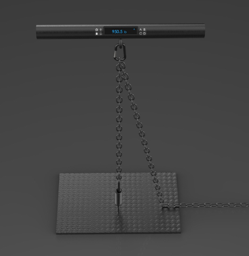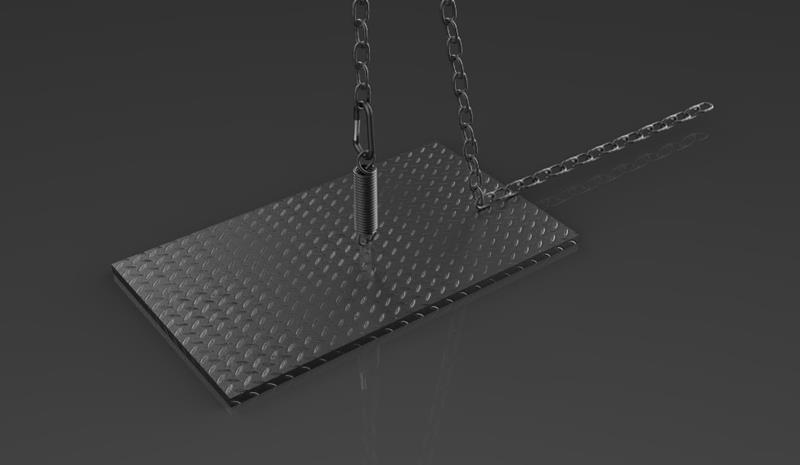Design Features That Make the ISOCHAIN the Ultimate Isometric Problem Solver—and Make it the Strength Gift that Keeps on Giving
What is the ISOCHAIN?
The ISOCHAIN is a bleeding-edge, digital version of a (now) little-known piece of old-school hardcore training equipment: the isometric chain-and-bar device.

Bruce Lee swore by isometric training. Here, he adjusts his trusty chain-and-bar device, as young Brandon looks on.

The ISOCHAIN works on identical principles to the traditional chain-and-bar device, but with ultramodern materials and tech.
This equipment became hugely popular in elite strength circles in the fifties, being used by weightlifters, martial artists, strongmen, and other select athletes in the community. Chain-and-bar units were portable, convenient, and incredibly versatile—particularly compared to weighted methods of isometrics, performed with cumbersome, fully loaded barbells in the rickety jerry-rigged power racks of the day. They were also highly safe, and—most importantly—remarkably effective at building strength and muscle.
Want to know more about the scientifically-proven benefits of isometrics? Read the article here.
Despite their effectiveness—they are still utilized by some hardcore athletes today—the classic chain-and-bar device gradually fell out of use, due to two significant problems:
1. Progress is impossible to track. Although you can pull or push hard with almost unlimited power levels against a chain-and-bar device, there is no way to know the force levels you are achieving. This is a massive stumbling block, because progressive training is the Holy Grail of all strength methods—and without this feedback you cannot establish progress. This not only makes programming problematic, it also essentially kills training motivation. You are training blind—you literally have no idea what you’re doing, or capable of doing, in terms of workload.
2. Zero loading reflex. The nervous system puts protective blocks on the force output of the muscular system—it only allows maximum force to be expressed when there is a legitimate load to be dealt with. (Neurologists call this phenomenon cortical inhibition.) Imagine pushing against a tree—it’s actually very difficult to exert much force, because your nervous system blocks you; it doesn’t sense an external load, so it figures you don’t need the tension. But if the tree suddenly blew over and you had to hold it to stay alive, you could push much harder! This is due to the sudden "loading reflex" which tells your nervous system to turn off the muscular blocks it has put in place. Unfortunately, the classic chain-and-bar devices are completely solid and unmoving to push against—as a result there is no loading reflex.

The issue of loading reflex was solved in elite European Olympic weightlifting gyms in the sixties: a heavy-duty spring was added to the chain. This allows for a flexible, powerful "give" to any strength drill, and allows athletes to recruit maximum motor units due to the loading reflex. The ISOCHAIN takes this solution to the limit, and incorporates and super-high-quality alloy steel tension spring into the design.
The first problem—measurability—has proven a far more difficult issue to solve. Several forward-thinking Olympic coaches tried attaching mechanical dynamometers to the chain, however these never found wide appeal because the location of the meter made it visible only to an onlooker. If you wanted a measurable isometric workout, you needed feedback from someone shouting out the numbers. As a result, these were never an option for athletes training alone.
The ISOCHAIN solves this old problem in the most effective way possible, by including—for the first time in history—a modern illuminated digital force-meter in the center of the handle. No more guesswork. Force level feedback is super-accurate and instantaneous.
A tiny number of digital isometric chain-and-bar devices exist in elite sports academies and university sports science centers, and these are also highly accurate. Unfortunately, they are also bespoke-engineered and cost thousands and thousands of dollars, a prohibitive price for the average trainee interested in optimizing their strength through progressively measurable isometric training.
With the advent of the ISOCHAIN, the open "secret" of scientific isometric strength training is about to step out of the shadows of iron game history—for good.
21st CENTURY ISOS
The ISOCHAIN solves the problems inherent in all previous designs. Whereas traditional chain-and-bar devices included a small wooden plank as a footplate, the ISOCHAIN footplate is larger than previous incarnations, and is comprised of toughened black checkered steel for stability plus a solid grip. The new design also features steel spring-mechanism carabiners (snap-hooks) to allow athletes to rapidly and safely alter the length of the chain, at two-inch intervals. The industrial-strength heavy duty black steel chain is 86 inches long—extendable enough to allow even the tallest athlete to perform overhead presses.
Despite its sturdy construction—the unit can handle a thousand pounds of load!—the ISOCHAIN itself weighs only a few pounds, can be used in even the smallest of rooms, and can be quickly and easily stored in any small space (behind a sofa, under a bed, etc).
The handle—composed of tubular steel encased in rugged, high-impact plastic—conceals a highly sensitive load cell, which can determine force levels to a fraction of a pound. As you perform any drill with the device, this component registers the force levels involved and relays them to an internal CPU. The results are immediately displayed on the illuminated LED display in the center of the handle. For the first time, athletes can see exactly what forces they are working with, in real time—and truly accurate, scientific isometrics finally becomes available to the larger strength world with this technologically-evolved version of the classic, hardcore equipment.
The location of the digital display on the handle is a key innovation, which allows the athlete to easily view their stats during all standard exercises. In another ergonomic touch, the display is gently tilted 45 degrees towards the athlete, meaning that they can still clearly see the display, even when the handle is at eye-level (for example, during presses).
What if the bar is above your head, or behind you during a drill? No problem. Even if you can’t see the display—or if you don’t wish to look at it—the speaker in the handle will audibly tell you when you’ve reached target force levels. The ISOCHAIN takes complete care of you.
This as well as housing the digital console and a speaker, the handle component of the ISOCHAIN also contains the major Training Mode buttons which confer athletes instant and complete control over all aspects of their isometric training.
This leads us to yet another innovation built-in to this tool: the five Training Modes of the ISOCHAIN.
CUTTING-EDGE TECH: THE 5 TRAINING MODES
Although the device comprises the latest in force-registering tech, our design team made a deliberate effort to make it as simple to use as is logically possible. It’s less like an overcomplex modern gadget, and more like a classic Porsche 911—no bells and whistles, just the ultimate kick-ass street machine.
The ISOCHAIN is so easy to use, even a child could operate it, safely and effectively. But it’s also versatile enough that you can use it to train in any way you want: for general conditioning, peak strength, hypertrophy, endurance, or all of the above.
There are five basic Training Modes—five quick and easy ways to train with this tool, depending upon your strength and fitness goals:
- Feedback Mode: This is the default mode of the device. When the ISOCHAIN is on, the digital LED console on the handle tells you exactly how much force you are lifting, as weight, in real time. (you can choose between kilos or pounds, depending on your preference.) Brutally straightforward!
- Timed Mode: Extensive research indicates that the ideal isometric "rep" lasts just six seconds. There’s no need to look at a clock or watch to achieve this perfect rep, however. Just select Timed Mode, enter a target weight on the handle’s console, and start your drill. As soon as you reach or exceed your target weight, the buzzer sounds, with a higher pitch each second—a prolonged signal tells you when your six seconds is up. The audible signal takes complete care of you. You don’t even need to look at the display!
- Load Mode: Don’t want to be limited to six seconds? Want to customize your workout, and work your holds for more, or less time? Just select Load Mode, enter your target weight on the console and begin your drill. As soon as you reach or exceed this weight, the buzzer in the handle will sound, and won’t stop until you drop below that level. Simple.
- Max Mode: What if you’ve finished your drill, and you’re wondering what the highest weight you reached was? What was your PR today? No problem. Just push the Max Mode button and your peak force for the previous drill is displayed on the console. Coaches will tell you that it’s almost impossible to know the true maximum force levels an athlete can summon using a barbell, but you can easily discover this on an ISOCHAIN, with frontline digital accuracy: zero guesswork required.
- Average Mode: Want to know the average force level attained during any given drill? Just push the Average Mode button, and the CPU does the math for you. This is particularly useful if athletes are training for muscular stamina and want to record their progress in longer drills: want to know your average force output during one minute? Five minutes? Ten? No problem!
That’s the built-in Training Modes—want to know what drills you can perform on the ISOCHAIN? Pretty much anything you can do with a barbell! Check out some tried-and-true techniques, here.
Need more information on the science behind isometrics? Check out the article here.
Click here and secure your ISOCHAIN.
JOIN THE ISOMETRIC REVOLUTION
In the late nineties Dragon Door revolutionized the strength and conditioning world when we re-introduced kettlebells to Europe and America.
In 2001 Dragon Door revolutionized nutrition when we published Ori Hofmekler’s The Warrior Diet—the first ever book on intermittent fasting.
In 2010 Dragon Door revolutionized the training world again when we revived functional bodyweight strength training worldwide, via the best-selling Convict Conditioning and the Kavadlo Brothers’ books and certs.
Those "in the know" in the fitness world watch Dragon Door very carefully—because this is the House Where Revolutions Begin. And it’s about to happen again. We invite you to join us now!
Still got questions about the science, the design, or the programming of isometrics and the ISOCHAIN? Contact our research team and we will get you the answers you need, as a priority: isochainproject@gmail.com
An appreciation of its value and breadth of application should restore isometrics to a place of importance in all training programs.
-Verkhoshansky, Supertraining